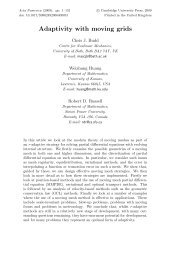Signature of phonon drag thermopower in periodically modulated ...
Signature of phonon drag thermopower in periodically modulated ...
Signature of phonon drag thermopower in periodically modulated ...
You also want an ePaper? Increase the reach of your titles
YUMPU automatically turns print PDFs into web optimized ePapers that Google loves.
ALAIN NOGARET PHYSICAL REVIEW B 66, 125302 2002<br />
m 2<br />
ql im c1 m,0,<br />
m n1<br />
<br />
4<br />
m,n1V xiVy m,n1V xiVy n1<br />
<br />
4<br />
m,n1V xiVy m,n1V xiVy, n2,3..., m...2,1,0,1,2... . 16<br />
A vector is <strong>in</strong>troduced which is def<strong>in</strong>ed as V n 0 “T/n .<br />
Mirl<strong>in</strong> and Wölfle observed 20,21 that equations <strong>of</strong> the type <strong>of</strong><br />
Eq. 15, albeit with no driv<strong>in</strong>g term ( m0), are satisfied<br />
by Bessel functions <strong>of</strong> complex order. The solutions <strong>of</strong> Eq.<br />
15 with m0 are: m(i) m J mi(1m,0 )/ c (qR c).<br />
These may be computed <strong>in</strong> the form <strong>of</strong> cont<strong>in</strong>ued fractions. 23<br />
1 0 <br />
1<br />
1 2 / 1<br />
1 1<br />
2 3 1 4 / 3<br />
4¯ Simplifications occur by observ<strong>in</strong>g that, for m0, Eq. 15<br />
gives 1 1 . Second, coefficients with negative values<br />
<strong>of</strong> m are elim<strong>in</strong>ated us<strong>in</strong>g: m m * and m m * .<br />
, 1<br />
0<br />
Third 3 ( 3) relates to 0 and 1 via 3( 1 2<br />
1)1 2 0 2 3( 1 * 2 *1)1 2 * 0<br />
2 *. These manipulations reduce Eqs. 18 to a system <strong>of</strong><br />
two equations with two complex unknowns 0 and 1 .<br />
Once 1 is known, the thermoelectric current immediately<br />
follows from<br />
j nS 00<br />
a dy<br />
a 0<br />
2 d<br />
2 F ny,yu 1 . 19<br />
The Fermi velocity (y) F1 cos(qy)F F(/2)cos(qy)O(2 ) is well approximated by its two<br />
lead<strong>in</strong>g terms s<strong>in</strong>ce 1. Equation 19 is then easily <strong>in</strong>tegrated,<br />
and I f<strong>in</strong>d<br />
<br />
j xnS 0<br />
2<br />
4 Re 1,<br />
<br />
j ynS 0<br />
2<br />
4 Im 1.<br />
20<br />
It should be remarked that Eq. 6 cannot be used here due to<br />
the coupl<strong>in</strong>g to higher (n1) harmonics. This is the reason<br />
why the current must be calculated from 1 rather than from<br />
0 . 2,21 Consider<strong>in</strong>g Eqs. 17 and 18, one notes that the<br />
125302-4<br />
i J1 <br />
J 1<br />
1<br />
1<br />
2 1<br />
3¯<br />
, i J1 <br />
J 1<br />
1<br />
2<br />
1<br />
1<br />
3¯<br />
17<br />
where the shorthand notation J 1J 1i/(c )(qR c) and J <br />
J i/(c )(qR c) is be<strong>in</strong>g used. 21 If electron-<strong>phonon</strong> <strong>in</strong>teraction<br />
has a tw<strong>of</strong>old symmetry, the Fourier coefficients <strong>in</strong> a 2<br />
and b 2 dom<strong>in</strong>ate <strong>in</strong> the Fourier expansion 9. In the first<br />
<strong>in</strong>stance, one may neglect the contribution <strong>of</strong> higher angular<br />
harmonics Eqs. 4, 8, etc. and solve Eq. 15 driven by<br />
the second harmonic only. This approach limits the number<br />
<strong>of</strong> fitt<strong>in</strong>g parameters to two one if b 20 In these conditions,<br />
V will have non zero components if n3 n1 is<br />
already accounted for. Equation 16 shows that m will be<br />
f<strong>in</strong>ite for m2 and 4. The solutions <strong>of</strong> Eq. 15 therefore<br />
take the form<br />
<br />
1<br />
2<br />
1<br />
1 2 / 1<br />
1<br />
3 1 4 / 3<br />
4¯<br />
. 18<br />
sequence <strong>of</strong> ratios cont<strong>in</strong>u<strong>in</strong>g beyond 4 ( 4) is common<br />
to both equations. The sequence <strong>of</strong> equations 17 is then<br />
substituted <strong>in</strong>to Eq. 18 which, after some algebra, reduces<br />
to a nonl<strong>in</strong>ear system <strong>in</strong> 0 and 1 :<br />
2 2<br />
r 1r 0ii 0 1 r 1i i 0 r0,<br />
21<br />
2 2<br />
i 1i 0ir 0 1 i 1i r 0 i0,<br />
where r , i , r , i ...Zr , Zi are the real and imag<strong>in</strong>ary<br />
parts <strong>of</strong><br />
1 21,<br />
i 2J 1 /J ,<br />
2/ 2 ,<br />
21Z, 22<br />
2/ 2 2Z,<br />
2 2 Z,<br />
Z 1<br />
2 3 2 33 1 3/ 2.<br />
4 has been replaced us<strong>in</strong>g the fact that, for n3, Eq. 16<br />
gives 40.5 2 . The real and imag<strong>in</strong>ary parts r , i , r ,
















